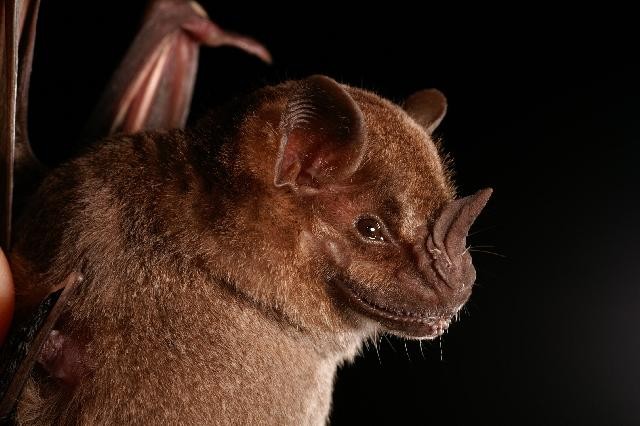Jamaican fruit bat
A species of Neotropical fruit bats, Also known as Mexican fruit bat Scientific name : Artibeus jamaicensis Genus : Neotropical fruit bats
Jamaican fruit bat, A species of Neotropical fruit bats
Also known as:
Mexican fruit bat
Botanical name: Artibeus jamaicensis
Genus: Neotropical fruit bats
Content
Description People often ask General Info
 Photo By Alex Borisenko, Biodiversity Institute of Ontario , used under CC-BY-SA-3.0 /Cropped and compressed from original
Photo By Alex Borisenko, Biodiversity Institute of Ontario , used under CC-BY-SA-3.0 /Cropped and compressed from original Description
The Jamaican fruit bat is a medium-sized bat, having a total length of 78–89 mm (3.1–3.5 in) with a 96–150 mm (3.8–5.9 in) wingspan and weighing 40 to 60 g (1.4 to 2.1 oz). It has broad but pointed and ridged ears with a serrated tragus. Its prominent noseleaf has an array of sebaceous glands. The lower lip is littered with warts with a relatively large one in the center. Sebaceous holocrine glands can be found in both lips. On the back the fur is an ashy-shade of gray or brown with visible white hair bases and variable fur patterning on the face. The wings of the fruit bat are broad and dark gray in color. The underfur is paler in color. The fruit bat has no external tail. It has broad dark grey wings and a narrow hairless interfemoral membrane with a short calcar. A transcriptome dataset is available with more than 25,000 annotated transcripts that are directly searchable by BLAST. A genome assembly has also been generated. 
Size
8 - 9 cm
Colors
Brown
Gray
Life Expectancy
9 years
Nest Placement
Tree
Feeding Habits
Jamaican fruit bat is primarily frugivorous, favoring figs which comprise over 78% of their diet at certain locations. They also consume leaves for protein. Jamaican fruit bat forages by plucking food and retreating to roosts to eat, aiding in seed dispersal.
Habitat
This species is found in a variety of habitats. It prefers habitats that are humid and tropical but has also adapted to cloud forests and drier tropical habitats. Fruit bats roost in caves, hollow trees, dense foliage, buildings and leaf tents. The fruit bat may create its own "tent" to roost in by altering broad leaves. These "tents" are only temporarily used.
Dite type
Frugivorous
People often ask
General Info
Feeding Habits
Bird food type

Fruit
Behavior
When in their roosts, the Jamaican fruit bat has a reproductive system known as "resource defensive polygyny". That is, males will claim an area as a territory and females select the best territories to roost and mate in. Subadult males may remain in their natal roosts while females may leave to gather with other females elsewhere. In caves where there are enough roosting sites, there is some "female defensive polygyny". Here, harem males actively defend females during the breeding seasons and will attack satellite males that roost in the walls and ceilings of caves. However, they tolerate males who are subordinate to them in their harems. Satellite males are more common in large groups than smaller groups and dominant and subordinate males will cooperate to defend harem females. In large groups, dominant males may be the fathers of the subordinates. When bats going on foraging trips, it is the dominant males that are the first to leave to the roosting sites and the last to return. At dusk, males spend much time flying near the tree roosts displacing any intruders. Jamaican fruit bats are most active at midnight; following that, activity begins to die down. When captured, a Jamaican fruit bat will warn conspecifics with a distress call made of a long series of pulses typically lasting 15 kHz. The Jamaican fruit bat will also react to the distress calls of other species and to their own recorded calls. The fruit bat is considered a whisper bat and makes 3 low-intensity FM pulses during flight and when resting. Breeding in the Jamaican fruit bat that is bimodal and polyestrous with births being dependent on fruit abundance. Females give birth twice a year with one young on average for each birth. Mating is highest at the end of the wet season and births take place in the dry months. Embryonic development may delay in the second breeding season but parturition will occur in the follow breeding period. The testes of the males enlarge when females enter estrous. The testes tend to be slightly larger in harem males than bachelors and the canine teeth tend to be more worn in the former. Copulation occurs until 2–25 days after the previous births. Pups born in a harem may sometimes be sired by satellite or subordinate males depending on the size of the group. Gestation is usually 3.5–4 months but can be as long as 7 months when there's delayed embryonic development. The female gives birth while perching and the newborn emerges unaided, head first. The mothers will eat the placenta. Mothers carry their pups when they are one day old but later leave them in the roosting area for the day. The female’s nipples become enlarged during lactation. Young are weaned by 15 days. Young gain a full, permanent set of teeth at 40 days and can fly by 50 days when their forearms are fully developed. Females are sexually mature by eight months and males by 12 months. 

 Photo By Alex Borisenko, Biodiversity Institute of Ontario , used under CC-BY-SA-3.0 /Cropped and compressed from original
Photo By Alex Borisenko, Biodiversity Institute of Ontario , used under CC-BY-SA-3.0 /Cropped and compressed from original Scientific Classification
Phylum
Chordates Class
Mammals Order
Bats Family
Leaf-nosed bat Genus
Neotropical fruit bats Species
Jamaican fruit bat